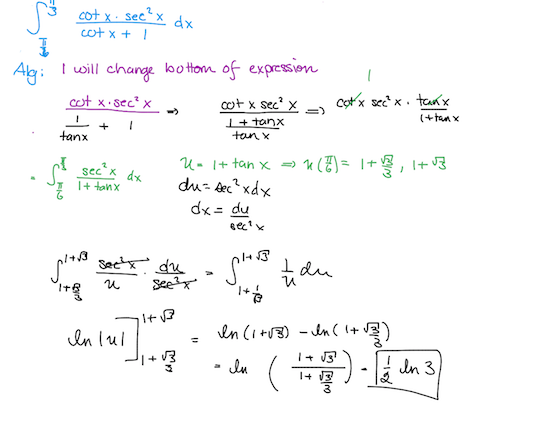Simplify Before Subbing
Evaluate:
∫ 6 π 3 π cot ( x ) + 1 cot ( x ) sec 2 ( x ) d x
This section requires Javascript.
You are seeing this because something didn't load right. We suggest you, (a) try
refreshing the page, (b) enabling javascript if it is disabled on your browser and,
finally, (c)
loading the
non-javascript version of this page
. We're sorry about the hassle.
4 solutions
the boundary of the 3rd row should be tan(pi/6) to tan(pi/3), not arctan(x), nice solution tho
brilliant! is your motivation is 'to only work with tan x and sec x ' ?
I don't like cot or sec, so I rewrite everything:
cot ( x ) + 1 cot ( x ) sec 2 ( x ) = sin ( x ) cos ( x ) + 1 sin ( x ) cos ( x ) 1 = cos ( x ) + sin ( x ) cos ( x ) 1
= cos ( x ) ( cos ( x ) + sin ( x ) ) 1
To integrate, it's better to have a sum of simplier fractions:
cos ( x ) ( cos ( x ) + sin ( x ) ) 1 = cos ( x ) sin ( x ) + cos ( x ) + sin ( x ) cos ( x ) − sin ( x )
That was a good idea as we have now:
cos ( x ) sin ( x ) + cos ( x ) + sin ( x ) cos ( x ) − sin ( x ) = − cos ( x ) cos ′ ( x ) + cos ( x ) + sin ( x ) ( cos ( x ) + sin ( x ) ) ′
After integrating, we have:
− ln ( cos ( x ) ) + ln ( cos ( x ) + sin ( x ) ) = ln ( cos ( x ) cos ( x ) + sin ( x ) ) = ln ( 1 + tan ( x ) )
Which evaluates to:
ln ( 1 + 3 ) − ln ( 1 + 3 1 ) = ln ( ( 3 + 1 ) / 3 1 + 3 ) = ln ( 3 ) = 2 1 ln ( 3 ) .
I like it! Breaking things down into constituent sines and cosines makes a problem easier sometimes.
First, begin by multiplying the integrand by tan ( x ) tan ( x ) . This transforms the integrand from cot ( x ) + 1 cot ( x ) sec 2 ( x ) to 1 + tan ( x ) sec 2 ( x ) .
Now we use the appropriate substitution, u = 1 + tan ( x ) , thus transforming the integral into ∫ u d u
Integrating and back-substituting gives us ln ( 1 + tan ( x ) ) ∣ ∣ ∣ 6 π 3 π = ln ( 1 + 3 ) − ln ( 1 + 3 3 ) = 2 1 ln ( 3 )

Let the integral be I , then:
I = ∫ 6 π 3 π cot x + 1 cot x sec 2 x d x × tan x tan x = ∫ 6 π 3 π 1 + tan x sec 2 x d x Let t = tan x ⇒ d t = sec 2 x d x = ∫ 3 1 3 1 + t 1 d t = ln ( 1 + t ) ∣ ∣ ∣ ∣ 3 1 3 = ln ( 1 + 3 1 1 + 3 ) = ln 3 = 2 1 ln 3